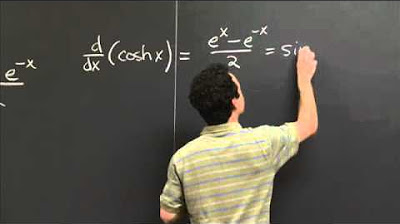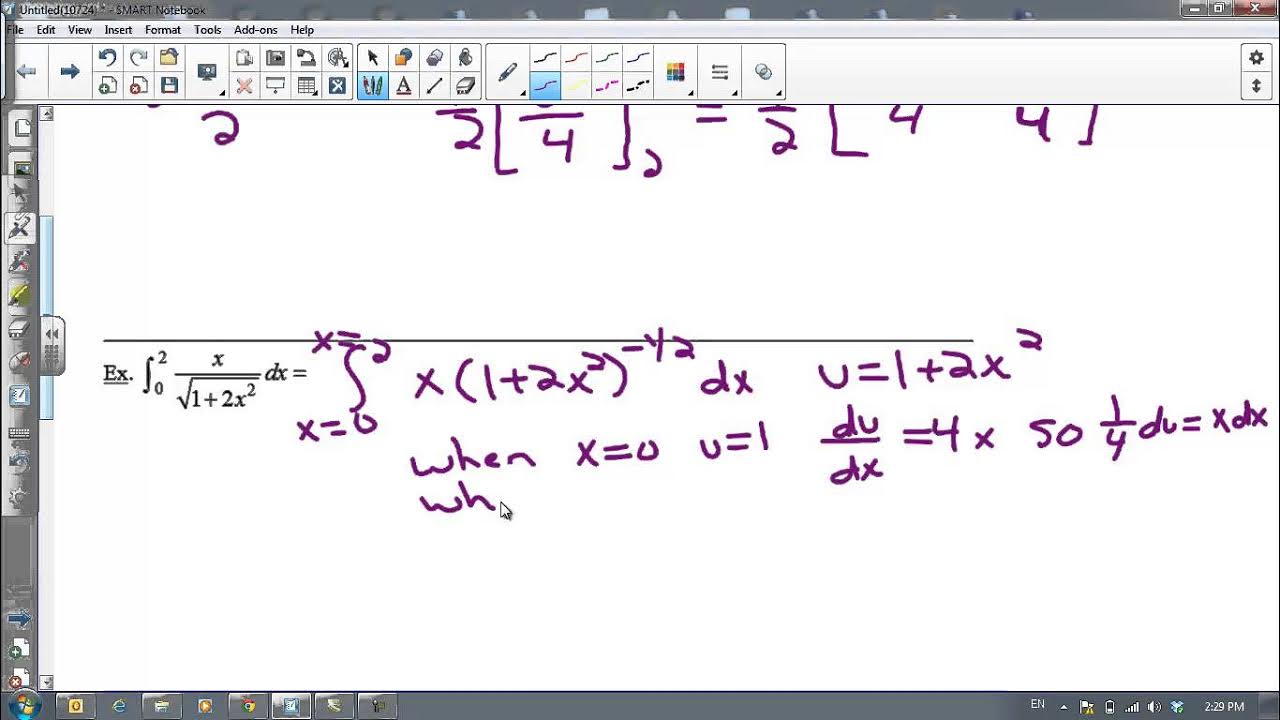Hyperbolic Trig Sub | MIT 18.01SC Single Variable Calculus, Fall 2010
TLDRIn this educational video, the instructor introduces a hyperbolic trigonometric substitution technique for solving integrals. The lesson focuses on calculating the area under a hyperbola using the hyperbola equation \( x^2 - y^2 = 1 \) and a point \( (cosh(t), sinh(t)) \). The instructor guides the audience through setting up the integral and suggests a substitution based on the hyperbolic identity \( sinh^2(u) + 1 = cosh^2(u) \) to simplify the problem. The video concludes with the integral's solution and a comparison to the regular trigonometric functions, highlighting the utility of hyperbolic trig substitutions in certain integral forms.
Takeaways
- 📚 The lesson introduces a variation on trigonometric substitution known as hyperbolic trigonometric substitution, used to simplify integrals of certain forms.
- 📐 The example provided involves a hyperbola defined by the equation \( x^2 - y^2 = 1 \) and a point on the hyperbola at coordinates \( (\cosh(t), \sinh(t)) \).
- 🔍 The formulas for hyperbolic cosine \( \cosh(t) \) and hyperbolic sine \( \sinh(t) \) are given as \( \cosh(t) = \frac{e^t + e^{-t}}{2} \) and \( \sinh(t) = \frac{e^t - e^{-t}}{2} \).
- 📈 The region of interest for finding the area is bounded by the hyperbola, the x-axis, and a line segment from the origin to the point \( (\cosh(t), \sinh(t)) \).
- 🔺 The integral to find the area is set up by considering horizontal rectangles and integrating with respect to \( y \) from 0 to \( \sinh(t) \).
- ✂️ The integral is split into two parts: one involving the square root of \( y^2 + 1 \) and another involving \( y \) multiplied by a constant.
- 🔄 A hyperbolic trig substitution \( y = \sinh(u) \) is suggested to simplify the square root part of the integral, leveraging the identity \( \sinh^2(u) + 1 = \cosh^2(u) \).
- 📉 The substitution simplifies the integral to \( \int \cosh^2(u) \, du \), which can be further simplified using the exponential form of the hyperbolic cosine function.
- 📝 The integral is computed in two steps: first, integrating the polynomial part directly, and second, applying the hyperbolic trig substitution to the square root part.
- 🧩 The final area of the region is found to be \( \frac{t}{2} \), which is a neat result highlighting the relationship between the hyperbolic function and the area under consideration.
- 🔑 The lesson concludes with the insight that hyperbolic trig substitutions can be a powerful tool in integral calculus, especially for integrals that exhibit certain forms.
Q & A
What is the main topic discussed in the video script?
-The main topic discussed in the video script is the hyperbolic trigonometric substitution, a technique used in calculus to solve integrals involving hyperbolic functions.
What is the hyperbolic trigonometric substitution?
-The hyperbolic trigonometric substitution is a method used to simplify the integration of functions that resemble the form of a hyperbolic identity, such as \( \sqrt{y^2 + 1} \), by substituting with a hyperbolic function, in this case, \( y = \sinh(u) \).
What is the region whose area is being calculated in the script?
-The region whose area is being calculated is the area below the line segment connecting the origin to the point \( (\cosh(t), \sinh(t)) \) on the hyperbola \( x^2 - y^2 = 1 \), above the x-axis, and to the left of the hyperbola's right branch.
What are the coordinates of the chosen point on the hyperbola?
-The chosen point on the hyperbola has coordinates \( (\cosh(t), \sinh(t)) \), where \( \cosh(t) \) is the hyperbolic cosine and \( \sinh(t) \) is the hyperbolic sine of \( t \).
What is the integral set up to find the area of the region?
-The integral set up to find the area of the region is an integral with respect to \( y \), from \( y = 0 \) to \( y = \sinh(t) \), of the difference between the rightmost x-coordinate, \( \sqrt{y^2 + 1} \), and the leftmost x-coordinate, \( \frac{\cosh(t)}{\sinh(t)}y \).
What is the significance of the hyperbolic identity used in the substitution?
-The hyperbolic identity \( \sinh^2(u) + 1 = \cosh^2(u) \) is used to simplify the integrand \( \sqrt{y^2 + 1} \) after the substitution \( y = \sinh(u) \), allowing the integral to be expressed in terms of \( \cosh(u) \), which is easier to integrate.
How does the script suggest simplifying the integral involving \( y \)?
-The script suggests simplifying the integral involving \( y \) by recognizing it as a constant times \( y \) and then integrating from 0 to \( \sinh(t) \), resulting in \( -\frac{\cosh(t)\sinh(t)}{2} \).
What is the final result of the area calculation?
-The final result of the area calculation is \( \frac{t}{2} \), which is obtained by adding the results of the two integrals after applying the hyperbolic trigonometric substitution.
What is the analogy mentioned at the end of the script between hyperbolic trig functions and regular trig functions?
-The analogy mentioned is that just as the area of a triangle formed by a point on a unit circle at \( (\cos(\theta), \sin(\theta)) \) is \( \frac{\theta}{2} \), the area of the region under consideration in the script is \( \frac{t}{2} \), where \( t \) plays a similar role to \( \theta \) in measuring the area.
What is the practical application of the hyperbolic trig substitution discussed in the script?
-The practical application of the hyperbolic trig substitution discussed in the script is to solve integrals of certain forms more efficiently, particularly when the integrand resembles a hyperbolic identity, offering an alternative to traditional trigonometric substitutions.
Outlines
📚 Introduction to Hyperbolic Trigonometric Substitution
The video begins with an introduction to a special type of trigonometric substitution, specifically the hyperbolic trigonometric substitution, which is used to simplify the computation of areas under certain curves. The presenter illustrates the concept by discussing a problem involving the area under a hyperbola defined by the equation x^2 - y^2 = 1. A point on this hyperbola is given as (cosh t, sinh t), where cosh and sinh are the hyperbolic cosine and sine functions, respectively. The presenter sets up the integral to find the area of the region bounded by the hyperbola, the x-axis, and a line segment from the origin to the point (cosh t, sinh t), and suggests using horizontal rectangles for the integration due to its simplicity.
🔍 Setting Up the Integral for Area Calculation
The presenter continues by detailing the process of setting up the integral to calculate the area of the specified region. The integral is set up with respect to y, integrating from y = 0 to y = sinh t. The right and left bounds for the x-coordinates of the rectangles are determined by the hyperbola's equation and the line passing through the origin, respectively. The integral to be evaluated involves the square root of y squared plus 1, which is simplified by recognizing it as the hyperbolic cosine function. The presenter also addresses the integral of a constant times y, which is straightforward to solve.
🧑🏫 Applying Hyperbolic Trigonometric Substitution
The presenter suggests a hyperbolic trig substitution, y = sinh u, to simplify the integral involving the square root of y squared plus 1. This substitution is based on the hyperbolic identity sinh squared u plus 1 equals cosh squared u. The presenter guides the viewer to make this substitution, change the differential from dy to du, and adjust the integration bounds accordingly. The integral then becomes a simpler form involving cosh squared u, which can be integrated using the exponential function representation of the hyperbolic cosine.
📈 Conclusion and Analogy with Regular Trigonometric Functions
The presenter concludes by solving the integral and finding the area of the region to be t over 2, where t is the parameter in the hyperbolic functions. The result is highlighted as a neat analogy to the area calculation in regular trigonometric functions, where the area under the curve from 0 to theta is theta over 2. The presenter emphasizes the usefulness of hyperbolic trig substitutions in integrals that suggest their form and encourages viewers to consider them as part of their mathematical toolkit.
Mindmap
Keywords
💡Hyperbolic Trigonometric Substitution
💡Hyperbola
💡Cosh and Sinh
💡Integral
💡Area Computation
💡Vertical and Horizontal Rectangles
💡Trigonometric Identity
💡Substitution
💡Exponential Functions
💡Hyperbolic Cotangent
💡Analytical Geometry
Highlights
Introduction to hyperbolic trigonometric substitution as a variation of trig substitution.
The problem involves computing the area of a region bounded by a hyperbola and a line segment.
The hyperbola equation is x^2 - y^2 = 1, with a point (cosh t, sinh t) on it.
Definitions of hyperbolic cosine (cosh t) and sine (sinh t) using exponential functions.
Explanation of how the point (cosh t, sinh t) lies on the right branch of the hyperbola.
The choice between vertical and horizontal rectangles for integration, with a preference for the latter.
Setting up the integral for the area using horizontal rectangles and the bounds on y.
Solving for x in terms of y to find the rightmost x-coordinate of the rectangles.
The leftmost x-coordinate is derived from the line equation y = sinh t / cosh t * x.
The integral to find the area involves a square root of y squared plus 1.
Suggestion of a hyperbolic trig substitution y = sinh u to simplify the integral.
The use of the hyperbolic identity sinh^2 u + 1 = cosh^2 u in the substitution.
Integration of the polynomial part of the integral involving y.
Application of the hyperbolic trig substitution to the square root part of the integral.
Transformation of the integral using the substitution and hyperbolic identity.
Integration of the resulting expression involving cosh^2 u.
Simplification of the integral using exponential functions for cosh.
Final computation of the integral and the area of the region.
Observation of the analogy between the area measured by theta in circle trigonometric functions and t in hyperbolic functions.
Conclusion on the utility of hyperbolic trig substitution in certain integral forms.
Transcripts
Browse More Related Video

Hyperbolic trig functions | MIT 18.01SC Single Variable Calculus, Fall 2010

GENERAL EQUATION OF THE HYPERBOLA IN STANDARD FORM || PRE-CALCULUS

U-Substitution with Definite Integrals

Line integral example 1 | Line integrals and Green's theorem | Multivariable Calculus | Khan Academy

Lec 28 | MIT 18.01 Single Variable Calculus, Fall 2007

Lesson 4 - Inverse Hyperbolic Functions (Calculus 2 Tutor)
5.0 / 5 (0 votes)
Thanks for rating: